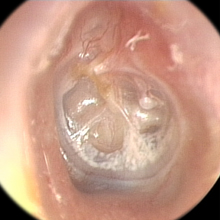| Tympanic membrane retraction | |
|---|---|
 | |
| Endoscopic image of retracted left tympanic membrane |
Tympanic membrane retraction describes a condition in which a part of the eardrum lies deeper within the ear than its normal position.
The eardrum comprises two parts: the pars tensa, which is the main part of the eardrum, and the pars flaccida, which is a smaller part of the eardrum located above the pars tensa. Either or both of these parts may become retracted. The retracted segment of eardrum is often known as a retraction pocket. The terms atelectasis or sometimes adhesive otitis media can be used to describe retraction of a large area of the pars tensa.
Tympanic membrane retraction is fairly common and has been observed in one quarter of a population of British school children.[1] Retraction of both eardrums is less common than having a retraction in just one ear. It is more common in children with cleft palate.[2] Tympanic membrane retraction also occurs in adults.[3][4]
Attempts have been made to categorise the extent of tympanic membrane retraction[3][4][5] though the validity of these classifications is limited.[2]
- ^ Maw, AR; Hall AJ; Pothier DD; Gregory SP; Steer CD. (2011). "The prevalence of tympanic membrane and related middle ear pathology in children: a large longitudinal cohort study followed from birth to age ten". Otology & Neurotology. 32 (8): 1256–61. doi:10.1097/mao.0b013e31822f10cf. PMID 21897314. S2CID 13913918.
- ^ a b James AL, Papsin BC, Trimble K, Ramsden J, Sanjeevan N, Bailie N, Chadha NK (May 2012). "Tympanic membrane retraction: An endoscopic evaluation of staging systems". Laryngoscope. 122 (5): 1115–20. doi:10.1002/lary.23203. PMID 22374833. S2CID 6122719.
- ^ a b Sadé, J; Berco E (1976). "Atelectasis and secretory otitis media". Ann Otol Rhinol Laryngol. 85 (2 Suppl 25 Pt 2): 66–72. doi:10.1177/00034894760850S214. PMID 1267370. S2CID 42460109.
- ^ a b Tos, M; Poulsen G (1980). "Attic retractions following secretory otitis". Acta Otolaryngol. 89 (5–6): 479–86. doi:10.3109/00016488009127165. PMID 7192477.
- ^ Borgstein, J; Gerritsma TV; Wieringa MH; Bruce IA (2007). "The Erasmus atelectasis classification: proposal of a new classification for atelectasis of the middle ear in children". Laryngoscope. 117 (7): 1255–9. doi:10.1097/mlg.0b013e31805d0160. PMID 17603325. S2CID 21170363.